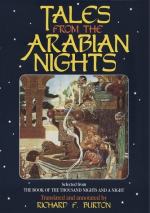The publication of this work puts an end to the numerous conjectures of scholars as to the source of Galland’s unidentified tales; and the notes on various MSS. of the Nights are also very valuable. It therefore appears desirable to give a tolerably full sketch of the contents of the book.[FN#431]
M. Zotenberg begins with general remarks, and passes on to discuss Galland’s edition. [Section I.]—Although Galland frequently speaks of Oriental tales[FN#432], in his journal, kept at Constantinople in 1672 and 1673, yet as he informs us, in his Dedication to the Marquise d’O., he only succeeded in obtaining from Syria a portion of the Ms. of the Nights themselves with considerable difficulty after his return to France.
There is some doubt as to the date of appearance of the first 6 vols. of Galland’s “Mille et une Nuit.” According to Caussin de Perceval, vols. 1 and 2 were published together in 1704, and vols. 3 and 4 in the course of the same year. Nevertheless, in the copy in the Bibliotheque Nationale, vols. 1 and 4 are dated 1704, and vols. 2, 5 and 6 are dated 1705; vol. 3 is missing, just as we have only odd volumes of the 2nd, 3rd and 4th English editions in the British Museum, the 1st being still quite unknown.
M. Zotenberg proceeds to give an account of Galland’s Ms. (cf. Nights, x. App., p. 414), and illustrates it by a specimen page in facsimile. Judging from the character of the writing, &c., he considers it to have been transcribed about the second half of the 14th century (Sir R. F. Burton suggests about A.D. 1384). It is curious that there is a Ms. of the 15th century in the Library of the Vatican, which appears to be almost a counterpart of Galland’s, and likewise contains only the first 282 Nights. Galland’s Ms. wants a leaf extending from part of Night 102 to the beginning of Night 104, and containing an account of the Hunchback and his buffooneries; this hiatus is filled up in the Vatican Ms.
Habicht’s version is noted as more approaching Galland’s Ms. than do the texts founded on the Egyptian texts; but in thus speaking, Zotenberg does not notice the assertion that Habicht’s Ms., though obtained at Tunis, came originally from Egypt. He considers the ordinary Egyptian texts to be generally abridged and condensed.
Although it is clear that Galland made great use of this Ms. for his translation, yet M. Zotenberg points out numerous discrepancies, especially those at the commencement of the work, which led Caussin de Perceval to regard Galland’s work as a mere paraphrase of the original. M. Zotenberg, however (p. 14), writes, “Evidemment, Galland, pour la traduction du commencement du recit, a suivi un texte plus developpe que celui du Ms. 1508, texte dont la redaction egyptienne ne presente qu’un maladroit abrege.” He quotes other instances which seem to show that Galland had more than one text at his disposal.




